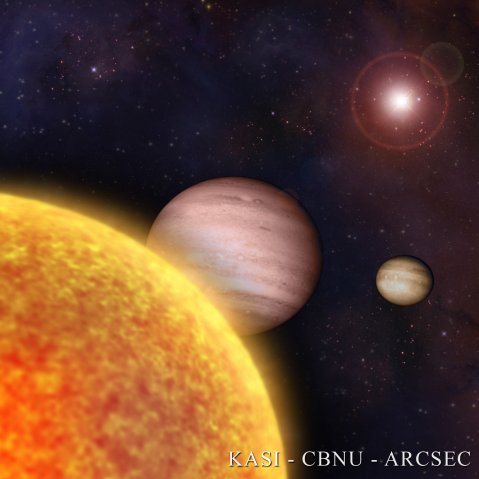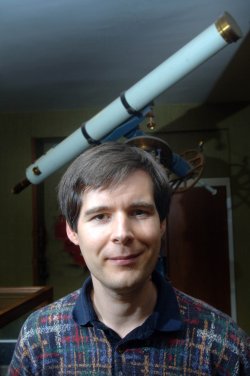Researchers find two new ‘unlonely planets’

Astronomers from the University of St Andrews have discovered a new system of planets with `striking similarities’ to our own Solar system.
Part of an international team, the researchers have found two new planets, similar to Jupiter and Saturn and 5,000 light years away. Orbiting a star half the mass of the Sun, the planets were discovered using a world-wide net of telescopes – including the UK’s Liverpool Telescope on the Canary Islands. The latest finding brings the search for new planets `closer and closer to home’.
 The St Andrews planet hunters, Dr Martin Dominik and Professor Keith Horne, made essential contributions to the discovery of an Earth-like planet in early 2006 using the same technique.
The St Andrews planet hunters, Dr Martin Dominik and Professor Keith Horne, made essential contributions to the discovery of an Earth-like planet in early 2006 using the same technique.
Their recent finding, released on St Valentine’s Day, suggests that planets do not favour the single-life but are more likely to be found in family groups. The two new planets are systematically named OGLE-2006-BLG-109Lb and OGLE-2006-BLG-109Lc. Dr Dominik, Royal Society University Research Fellow at the St Andrews’ School of Physics & Astronomy, said, “Our gravitational microlensing technique is currently best suited for studying extra-solar planets that resemble the gas giants of the Solar System. This system of planets bears a remarkable similarity to our Solar System, with the ratios of their properties remarkably close to those of Jupiter and Saturn.
“Our finding also suggests that lonesome gas-giant planets are the exception and planetary systems are the rule. It seems that planets do not like being lonely hearts.”
Besides the two new planets, their host star may be surrounded by further planets, similar to others within our own Solar system, although there is no evidence for that.
“The lack of further planetary signals makes it plausible that the more massive of the two planets – OGLE-2006-BLG-109Lb – is the innermost giant planet orbiting its parent star, leaving room for terrestrial planets (like Mercury, Venus, Earth, and Mars) to reside inside its orbit. Moreover planets taking the role of Uranus and Neptune, respectively, could also be present,” explained Dr Dominik.
“While most planetary systems around other stars substantially differ from the Solar system, a series of recent detections have brought us closer and closer to home. Sooner rather than later, someone can be expected to discover an Earth-mass planet orbiting a star other than the Sun – and it could be us. In fact, with our ARTEMiS (Automated Robotic Terrestrial Exoplanet Microlensing Search) expert system, even less massive planets could bedetected,” he said.
The Liverpool Telescope data that formed part of the discovery of the two new planets were taken as part of the RoboNet microlensing programme, which exploits three robotic telescopes with a diameter of 2 metres, the largest of their kind in the world.
Professor Keith Horne, who leads the programme, points out that microlensing searches can act as vital part of a roadmap towards further space missions. “Apart from individual spectacular discoveries, the technique of gravitational microlensing allows to infer a census of planets within the Milky Way. Once we know that planets similar to Earth are common, it is straightforward to go ahead with finding them and investigating whether these harbour any forms of life,” he explained.
ENDS
NOTE TO EDITORS:
THE RESEARCHERS ARE AVAILABLE FOR INTERVIEW:
Dr Martin Dominik – email (preferred method) [email protected] or tel: 01334 463068 / 01334 470305 / 07753-388 787.
Professor Keith Horne, Tel: 01334-463 322 / 01334 470894 / 07770 728321 or email [email protected]
IMAGES AND MOVIES
Further background information and images are available at:
http://www.artemis-uk.org/highlights/unlonely_planets/description.html
CREDIT KASI/CBNU/ARCSEC
(KASI: Korea Astronomy and Space Science Institute, CBNU: Chungbuk National University,
ARCSEC: Astrophysical Research Center for the Structure and Evolution of the Cosmos)
For more information about ARTEMiS, visit www.artemis-uk.org
For more information on RoboNet visit – www.astro.livjm.ac.uk/RoboNet/
Issued by the Press Office, University of St Andrews
Contact Gayle Cook, Press Officer on 01334 467227 / 462529, mobile 07900 050 103, or email [email protected]
Ref: unlonely planets 130208
View the latest University press releases at www.st-andrews.ac.uk
Category Research